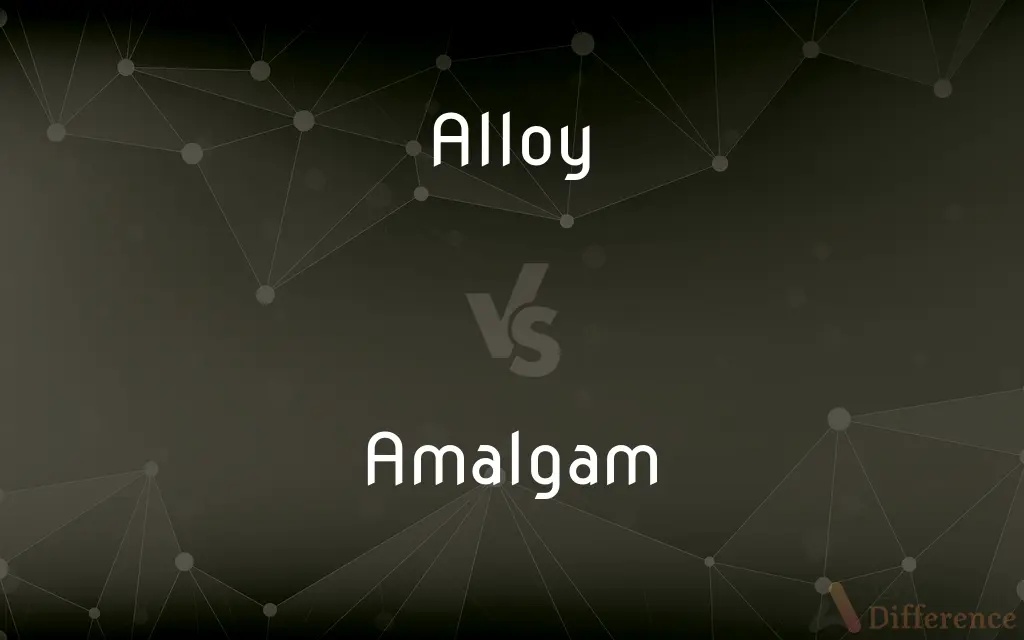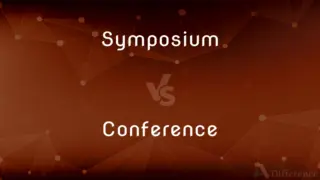Alloy vs. Amalgam — What's the Difference?
By Maham Liaqat & Urooj Arif — Updated on March 30, 2024
Alloys are mixtures of metals with other metals or elements, enhancing properties like strength and corrosion resistance, while amalgams specifically combine mercury with another metal, often used in dentistry.

Difference Between Alloy and Amalgam
Table of Contents
ADVERTISEMENT
Key Differences
Alloys are created by melting and mixing two or more metals, or a metal and a non-metal, to improve characteristics such as strength, durability, and resistance to corrosion. For instance, steel, an alloy of iron and carbon, is stronger and more flexible than pure iron. On the other hand, amalgams are a specific type of alloy in which mercury is combined with one or more other metals. Dental amalgam, made from mercury and a mixture of silver, tin, and copper, is a common example, valued for its durability and ease of use.
While alloys are utilized across various industries including construction, automotive, and electronics for their enhanced physical and chemical properties, amalgams are primarily used in dental restorations and some electrical applications due to their unique ability to harden at room temperature and adhere to metal surfaces. Whereas alloys can be designed to meet specific needs by adjusting the type and quantity of constituent elements, amalgams are limited by the properties of mercury and its reactions with other metals.
The production of alloys involves carefully controlled processes to achieve the desired mix and properties, such as melting point, malleability, and tensile strength. These processes may include smelting, casting, and annealing. Conversely, amalgams are produced by directly mixing liquid mercury with powdered metals, a process that requires special handling due to mercury's toxicity.
Alloys play a crucial role in material science and engineering, offering solutions to challenges in material strength, weight, and conductivity. Amalgams, due to health concerns associated with mercury, are seeing reduced usage in dentistry and other applications, with alternatives being sought that offer similar benefits without the risks.
Comparison Chart
Definition
A mixture of metals with other metals or elements.
A specific type of alloy involving mercury.
ADVERTISEMENT
Key Uses
Construction, automotive, electronics.
Mainly dental restorations, some electrical uses.
Composition
Can include various metals and non-metals.
Mercury combined with one or more other metals.
Properties Enhanced
Strength, durability, corrosion resistance.
Durability, ease of use, hardening at room temp.
Production Process
Smelting, casting, annealing.
Mixing liquid mercury with powdered metal.
Compare with Definitions
Alloy
Created to enhance the properties of metals.
Stainless steel, an alloy, is popular for its minimal rusting.
Amalgam
Contains mercury, requiring careful handling.
Amalgam waste must be disposed of properly to avoid environmental contamination.
Alloy
Can contain non-metals.
Silicon is added to steel to improve its magnetic properties.
Amalgam
A mixture of mercury with another metal.
Dental amalgam is used for its durability and ease of application.
Alloy
A mixture of two or more elements, where at least one is a metal.
Brass is an alloy of copper and zinc, known for its resistance to corrosion.
Amalgam
Specifically used where mercury's properties are beneficial.
Amalgams harden quickly, making them ideal for dental repairs.
Alloy
Offers versatility in material properties.
Alloys are developed for high conductivity or resistance to high temperatures.
Amalgam
Primarily used in dentistry.
Silver amalgam fillings have been common for decades.
Alloy
Utilized for specific engineering applications.
Aluminum alloys are used in aircraft for their strength-to-weight ratio.
Amalgam
Facing reduced usage due to health concerns.
Alternatives to amalgam are being used more frequently in dentistry.
Alloy
An alloy is an admixture of metals, or a metal combined with one or more other elements. For example, combining the metallic elements gold and copper produces red gold, gold and silver becomes white gold, and silver combined with copper produces sterling silver.
Amalgam
An alloy of mercury and silver used in dental fillings.
Alloy
A metallic solid or liquid that is composed of a homogeneous mixture of two or more metals or of metals and nonmetal or metalloid elements, usually for the purpose of imparting or increasing specific characteristics or properties
Brass is an alloy of zinc and copper.
Amalgam
An alloy of mercury and tin used in silvering mirrors.
Alloy
A mixture; an amalgam
"Television news has ... always been an alloy of journalism and show business" (Bill Moyers).
Amalgam
A combination of diverse elements; a mixture
An amalgam of strength, reputation, and commitment to ethical principles.
Alloy
The relative degree of mixture with a base metal; fineness.
Amalgam
(metallurgy) An alloy containing mercury.
Alloy
Something added that lowers value or purity.
Amalgam
A combination of different things.
Alloy
To combine (metals) to form an alloy.
Amalgam
One of the ingredients in an alloy.
Alloy
To combine; mix
Idealism that was alloyed with political skill.
Amalgam
To amalgamate.
Alloy
To debase by the addition of an inferior element.
Amalgam
An alloy of mercury with another metal or metals; as, an amalgam of tin, bismuth, etc.
Alloy
A metal that is a combination of two or more elements, at least one of which is a metal.
Amalgam
A mixture or compound of different things.
Alloy
(archaic) A metal of lesser value, mixed with a metal of greater value.
Gold without alloy
Amalgam
A native compound of mercury and silver.
Alloy
An admixture; something added which stains, taints etc.
Amalgam
To amalgamate.
Alloy
(figurative) Fusion, marriage, combination.
Amalgam
An alloy of mercury with another metal (usually silver) used by dentists to fill cavities in teeth; except for iron and platinum all metals dissolve in mercury and chemists refer to the resulting mercury mixtures as amalgams
Alloy
To mix or combine; often used of metals.
Amalgam
A combination or blend of diverse things;
His theory is an amalgam of earlier ideas
Alloy
To reduce the purity of by mixing with a less valuable substance.
To alloy gold with silver or copper, or silver with copper
Alloy
(figurative) To impair or debase by mixture.
To alloy pleasure with misfortunes
Alloy
Any combination or compound of metals fused together; a mixture of metals; for example, brass, which is an alloy of copper and zinc. But when mercury is one of the metals, the compound is called an amalgam.
Alloy
The quality, or comparative purity, of gold or silver; fineness.
Alloy
A baser metal mixed with a finer.
Fine silver is silver without the mixture of any baser metal. Alloy is baser metal mixed with it.
Alloy
Admixture of anything which lessens the value or detracts from; as, no happiness is without alloy.
Alloy
To reduce the purity of by mixing with a less valuable substance; as, to alloy gold with silver or copper, or silver with copper.
Alloy
To mix, as metals, so as to form a compound.
Alloy
To abate, impair, or debase by mixture; to allay; as, to alloy pleasure with misfortunes.
Alloy
To form a metallic compound.
Gold and iron alloy with ease.
Alloy
A mixture containing two or more metallic elements or metallic and nonmetallic elements usually fused together or dissolving into each other when molten;
Brass is an alloy of zinc and copper
Alloy
The state of impairing the quality or reducing the value of something
Alloy
Lower in value by increasing the base-metal content
Alloy
Make an alloy of
Common Curiosities
Can alloys contain non-metals?
Yes, alloys can contain non-metals, such as carbon in steel, to improve their properties.
Why are amalgams used in dentistry?
Amalgams are used in dentistry for their durability, ease of use, and ability to harden at room temperature, making them suitable for dental repairs.
Are there environmental concerns associated with amalgams?
Yes, there are environmental concerns, particularly due to the toxicity of mercury, requiring careful handling and disposal of amalgam waste.
What is an alloy?
An alloy is a mixture of two or more elements, where at least one is a metal, created to enhance properties such as strength or corrosion resistance.
How is an amalgam different from other alloys?
An amalgam is a specific type of alloy that includes mercury as one of its components, primarily used in dental restorations.
What makes alloys important in engineering?
Alloys are important in engineering for their enhanced properties, such as increased strength, durability, and corrosion resistance, making them suitable for various applications.
Is it safe to use amalgam for dental fillings?
While dental amalgam is considered safe for most people, concerns about mercury exposure have led to increased use of alternative materials.
What is the purpose of adding non-metals to alloys?
Adding non-metals to alloys can improve specific properties, such as hardness, electrical conductivity, or thermal resistance.
How are alloys made?
Alloys are typically made by melting and mixing the component metals, sometimes with additional processes like casting and annealing to achieve desired properties.
How does mercury affect the environment?
Mercury can be toxic to aquatic life and can accumulate in the food chain, posing health risks to animals and humans, hence the concern over amalgam use.
Are all metals capable of forming alloys?
Most metals can form alloys with other metals, but the ability and extent to which they can alloy depend on their chemical properties.
What are some common alloys and their uses?
Common alloys include steel (construction and manufacturing), brass (musical instruments and fixtures), and aluminum alloys (aircraft and automotive parts).
Can the composition of an alloy be adjusted?
Yes, the composition of an alloy can be adjusted to tailor its properties for specific applications or performance requirements.
Has the use of amalgam decreased?
Yes, the use of amalgam has decreased due to health and environmental concerns, with more dentists opting for safer, mercury-free alternatives.
What are the alternatives to dental amalgam?
Alternatives to dental amalgam include composite resins, glass ionomer cements, and ceramic materials, each with its own set of advantages.
Share Your Discovery

Previous Comparison
Symposium vs. Conference
Next Comparison
Correlation vs. CausationAuthor Spotlight
Written by
Maham LiaqatCo-written by
Urooj ArifUrooj is a skilled content writer at Ask Difference, known for her exceptional ability to simplify complex topics into engaging and informative content. With a passion for research and a flair for clear, concise writing, she consistently delivers articles that resonate with our diverse audience.
















































